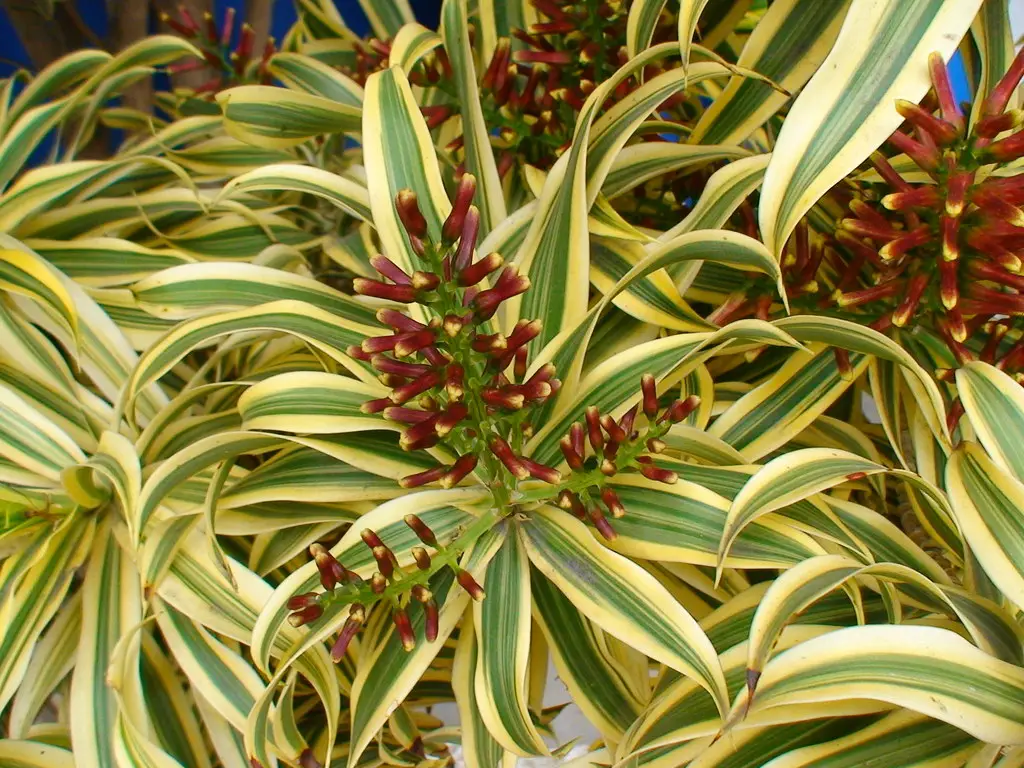The Dracaena, a genus comprised of a diverse group of resilient plants, is known for its ornamental value and suitability for indoor environments. With more than 120 different species, Dracaena plants vary widely in size, shape, and color. Often referred to as “Dragon Trees,” they can be found with colorful striped leaves, twisted stems, and sometimes fragrant flowers.
Originating from different parts of the world, including Africa, Asia, and Central America, Dracaenas are characterized by their long, sword-like leaves and woody stems. They are popular choices for homes and offices due to their ability to thrive in various light conditions and their low need for maintenance.
The diversity within the Dracaena genus has led to a broad range of aesthetic appearances, making these plants suitable for various interior styles. From the dramatic Dracaena marginata to the vibrant Dracaena fragrans, these plants can add a touch of nature and sophistication to any indoor space.
| Attribute | Details |
|---|---|
| Common Names | Dracaena, Dragon Tree |
| Botanical Name | Dracaena spp. |
| Family | Asparagaceae |
| Plant Type | Perennial |
| Mature Size | 2 to 10 feet, depending on species |
| Sun Exposure | Low to bright, indirect light |
| Soil Type | Well-draining, loamy soil |
| Hardiness Zones | 10-12 |
| Native Area | Africa, Asia, Central America |
Dracaena Care
Dracaenas are notably easy to care for, making them an ideal choice for those new to plant care or with busy schedules. These plants are adaptable to different lighting conditions, although they typically prefer indirect light. Too much direct sunlight can cause the leaves to burn, while too little can lead to dull or pale leaves.
When it comes to watering, Dracaena requires care and attention. Overwatering can lead to root rot, while underwatering may cause the leaves to become dry and crispy. The use of a well-draining soil mix, combined with a careful watering routine, can help avoid these issues.
Light Requirement for Dracaena
Dracaena plants are versatile in their light requirements. They can tolerate low light but will thrive best in medium to bright indirect sunlight. Avoid placing them in direct sunlight, as this can lead to scorching of the leaves.
Soil Requirements for Dracaena
A well-draining soil mix with a combination of loam, peat, and sand is ideal for Dracaena. Ensuring that the soil doesn’t hold too much moisture can prevent root rot and other water-related problems.
Water Requirements for Dracaena
Watering needs for Dracaena can vary based on the specific species and environmental conditions. Generally, the soil should be allowed to dry slightly between watering. Overwatering should be avoided, as it can lead to root rot.
Temperature and Humidity
Dracaena prefers temperatures between 60°F and 75°F (15°C to 24°C). Humidity levels between 40% to 50% are ideal, and misting can help in particularly dry environments.
Fertilizer
A balanced liquid fertilizer can be used during the growing season, generally from spring to early autumn. Fertilizing once a month is usually sufficient.
Pruning Dracaena
Pruning can be done to control the size or shape of the plant. Cutting back the tips of the plant can encourage bushier growth, while removing dead leaves helps maintain appearance.
Propagating Dracaena
Dracaena is commonly propagated through stem cuttings. The cut stem can be placed in water until roots develop, then transplanted into soil.
How To Grow Dracaena From Seed
Growing Dracaena from seed is possible but less common. Seeds can be sown in a well-draining soil mix and kept moist until germination.
Common Pests & Plant Diseases
Spider Mites
Regular misting and wiping of the leaves can prevent spider mites.
Mealybugs
Insecticidal soap can help control mealybugs.
Common Problems With Dracaena
Brown Leaf Tips
Caused by low humidity or fluoride in the water.
Yellow Leaves
Often a sign of overwatering or poor drainage.
Pro Tips
- Use filtered or distilled water if tap water contains fluoride, as Dracaena is sensitive to this chemical.
- Rotate the plant occasionally to ensure even growth.
- Monitor soil moisture regularly to avoid overwatering.
- Provide good air circulation to prevent pest infestations.
- Select the Dracaena species that fits your space and lighting conditions best, as they can vary greatly in appearance.




